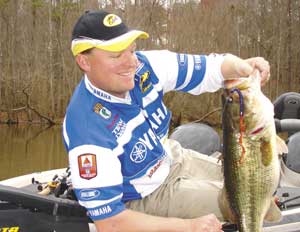
Do you want to catch lots of bass? Big bass?
Picking the right lure is as important to success as being in the right area at the right time of year. If you end up at the right areas, armed with the correct lures, you’ll have many remarkable catches.
I bug my buddies all the time telling them I found the perfect lure — but does it actually exist?
At a recent seminar I was asked, “How do you know what lure to use?” My answer? It depends.
The angler looked a little disturbed, so I wrote a chart on the board with contrasting lure traits and water conditions. This chart quickly teaches anglers the best lures to use.
In general, with clear calm conditions, you want to hide the lure from the bass, just like the baitfish are doing.
You also never want the bass to realize your lure isn’t food.
Lures that match the bottom’s color or are translucent tend to be natural-looking to fish.
You can accomplish this by following the chart. An example of a subtle lure is a 4-inch green-pumpkin worm.
For muddy water or cloudy days and wind, use just the opposite approach to lure selection. With those conditions, you want the bass to be able to see, hear and feel the lure. They may only be able to see it just before biting, so provide that obvious target.
An example of a totally aggressive lure is a chartreuse spinnerbait with a No. 6 Colorado blade, a bulky white trailer and a rattle.
But all lure types can have aggressive or subtle traits.
You also can go to different areas of a lake to find your favorite conditions. Up the lake of a stream-fed impoundment may have dirtier water, especially after a heavy rain, because of suspended particles washed into the stream that feeds the lake; downstream usually you’ll find clearer water because sediments have had time (and there’s less current) to settle to the bottom.
Practical examples
Let’s look at the extremes.
When the above conditions call for it, I recommend rigging several rods for a day of bass fishing.
One would be a bright spinnerbait with big blades, a big bright wide wobbling crankbait, and a solid white jig with rattles and bulky trailer.
However, if the day fits into the subtle column, you also should have several rods rigged. They could include a watermelon 4-inch finesse worm, small silent crankbait, small soft jerkbait, small hard jerkbait and a finesse jig.
I also want the fish to be looking into the sun to further camouflage my lure.
As conditions change, you can mix lure traits to better match conditions. For example, if the water is clear, but some clouds and wind are present, you can cross over and pick up one or two aggressive lure traits.
You might try a brighter color or some rattles to help draw attention to your lures — or, simply increase their sizes.
Any of the aggressive-lure traits will make your lures more noticeable to the bass. For example, if you were fishing a 4-inch worm without much success, try a 6-inch worm.
If you’ve got muddy water, but it’s sunny and calm, you might skip the rattles and let the fish find your lure by sensing only the vibration. That’s how Takahiro Omori won the 2004 Bassmasters Classic at Lake Wylie.
The water was muddy, but it was also calm and sunny. So he used a fat, chartreuse crankbait with no rattles to catch his last few winning fish.
At the other end of the lake where the water was clearer, Aaron Martens used a jig spin with a small soft jerkbait trailer.
Had either angler switched lures, it’s possible neither one would have caught anything.
Of course fishing pressure will upset this balance. so you’ll have to go more subtle to get bites at a lake that’s getting beaten to death, even in dingy water.
One of my favorite lures for a sunny clear-water day in early summer seems counterintuitive — a 12-inch red shad Culprit worm, better known as the “garden snake.”
It seems this lure would be totally aggressive, but it’s not. It’s quiet, moves naturally with low vibration and is thin.
The only thing aggressive about it is its large size, which appeals to hungry early summer bass. Even the color at first seems aggressive — red and black.
But when the worm is 10- to 20-feet deep, it appears much more natural as the sunlight diminishes. The bass might just see a hint of the two-tone color, which is a more natural look.
You might think only large bass would eat it, however bass of all sizes will “take the bait.”
(Editor’s note: The late Bryan Kerchal, a BASS Federation qualifier, captured the 1993 Classic at High Rock Lake during extremely muddy conditions in the main lake by using a red Culprit worm at docks where the water was clearer).
The key to picking the right lure is knowing how to mix aggressive and subtle lure traits to attract just the right amount of attention to your lures. You want to bass to be able to find the lure, yet the lure must be natural enough for the conditions to actually fool the fish into biting.
How many times have you wished for just a little wind? Wind hides your lure’s faults and noise from your boat.
Remember to always be aware of current conditions and be ready to make lure adjustments to improve your catch.
Dustin Wilks is a 29-year-old professional bass angler and Raleigh native now living in Rocky Mount. He has qualified for the Bassmaster Classic four times and operates Fish Like a Pro Fishing Lessons (252-883-6749, www.fishlikeapro.com ). His sponsors include Skeeter Boats, Yamaha, Daiwa, Keelshield and Culprit.



Be the first to comment